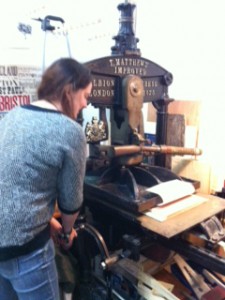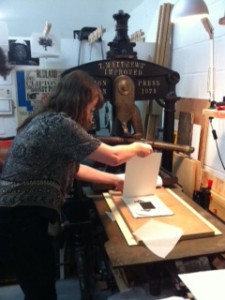Organising a printmaking workshop was slightly trickier than I expected, due to the equipment needed, and the health and safety implications. However a friend of mine and a fantastic printmaker Ben Goodman came to the rescue and allowed me to use his own personal equipment at BV studios, as well as be on hand for the evening. Two of the group, Jessica and Louise attended my workshop (I was quite grateful for the low numbers as teaching printmaking requires a lot of time and attention).
I began the workshop by showing them examples my own work and Ben’s work in order to illustrate the possibilities of relief printmaking. I had previously asked J and Louise to come up with some simple images – I felt that at this stage, and with them both being beginners, it didn’t really matter what they printed it was more about understanding the process. I then explained how their images could translate as prints and showed them how to transfer their images on to lino, then set them to work cutting. This stage was hard to teach because I know that when I cut my plates I probably break all the rules of relief printmaking, and I guess this is what makes my work original, but I had to try showing them the ‘proper’ ways of doing things, because you can’t break the rules until you have the basics. The process of cutting a plate is also about practice, the more you practice the better you get, it’s something that can’t really be taught straight off, so I let Louise and J get on with it however they wanted, giving them the odd tip along the way. At this stage there is no real right or wrong.
- Louise cutting her Lino plate
Once both plates were cut we moved on to ‘inking up’ – this is where you roll out your ink on to a surface and then transfer it on to your plate using a roller. This seems simple but there are a surprising amount of techniques when it comes to inking up. Me and Ben collaboratively explained the process before guiding them through inking up their plates.
Once the plates were inked up and ready to go, we set up the press and talked them though how it works, then we were ready to take the first print. J and Louise both operated the press themselves – this is important because printmaking relies on being able to ‘feel’ whether the press is set up correctly and set at the right pressure for your plate.
The prints came out really well and both J and Louise were really excited by what they had made which was great! I was worried because I thought that they might find the workshop boring because with printmaking you really do have to start with the basics and it takes time, but they were both so happy with what they had done and both wanted to go away and try doing more, which is fantastic!



